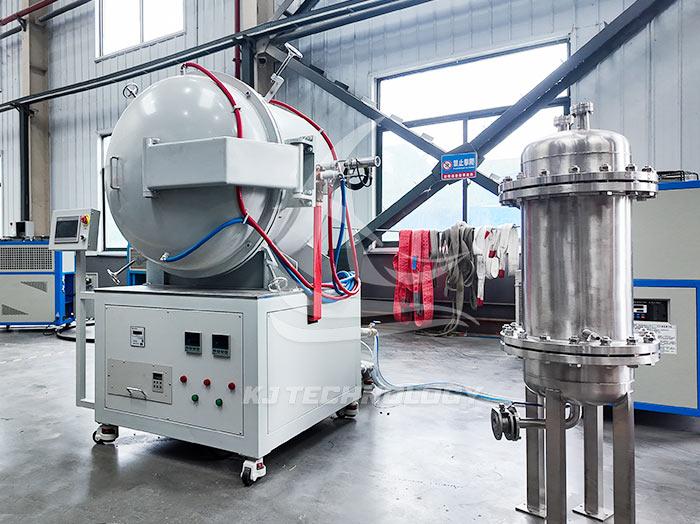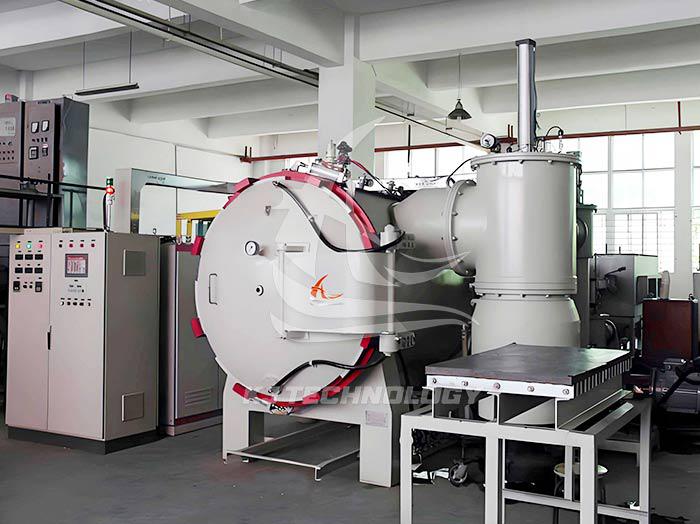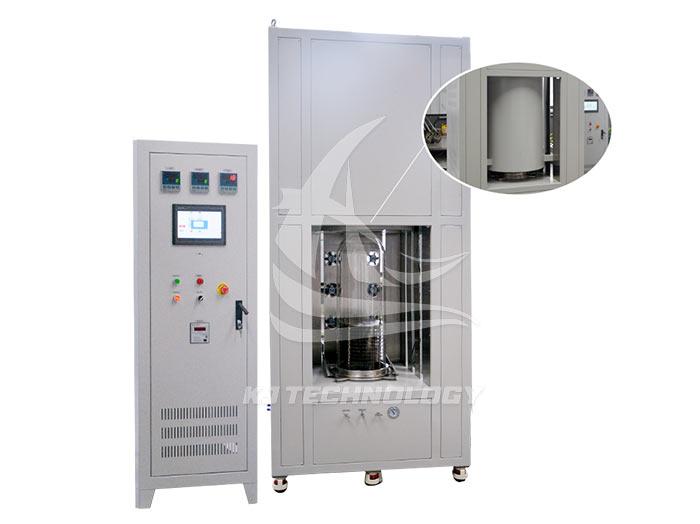Why do gas quenching furnaces need to be evacuated?
 10-27-2025 Author: KJ technology
10-27-2025 Author: KJ technology
Vacuuming the gas quenching furnace is a key step in ensuring the quality of heat treatment. Its core purpose is to create a pollution-free environment, prevent material oxidation and decarburization, improve cooling efficiency, and accurately control process parameters. The following is a detailed analysis of the specific reasons and effects:
1. Prevent material oxidation and decarburization
Oxidation problem
Metals react with oxygen at high temperatures to form oxide films (such as iron's Fe ∝ O ₄), resulting in surface roughness, size changes, and even reduced material properties (such as hardness and fatigue strength).
Example: Heating stainless steel in air will form an oxide scale, which affects its corrosion resistance; High speed steel may develop cracks after oxidation.
Decarbonization issue
Carbon containing materials (such as tool steel and bearing steel) react with oxygen or carbon dioxide at high temperatures, leading to a decrease in surface carbon content and the formation of a decarburization layer, resulting in a decrease in hardness and wear resistance.
Example: After decarburization, the quenching hardness of Cr12MoV steel may decrease.
The role of vacuum environment
After vacuuming, the oxygen concentration inside the furnace is extremely low, which can completely avoid oxidation and decarburization reactions, ensuring the surface smoothness and stable performance of the material.
2. Improve cooling efficiency
Limitations of gas cooling
Gas quenching achieves rapid cooling through forced convection of high-pressure gases (such as nitrogen and helium), but if impurities (such as moisture and oil mist) are mixed into the gas, it will reduce the heat conduction efficiency and affect the cooling rate.
Advantages of Vacuum Environment
Pure gas: The high-purity gas (such as 99.999% nitrogen) filled after vacuuming does not contain impurities and has higher thermal conductivity efficiency.
Uniform cooling: Vacuum environment can avoid gas flow obstruction, ensure consistent cooling speed of various parts of the workpiece, and reduce the risk of deformation and cracking.
Example: During high-pressure nitrogen quenching, the vacuum environment can increase the cooling rate and significantly improve the quenching effect.
3. Reduce process pollution
Source of impurities in the furnace
Ordinary heat treatment furnaces may have residual oil stains, dust, or residues from previous treatments, which can adhere to the surface of the workpiece and affect its quality.
Purification effect of vacuum environment
Vacuum pumping+reverse blowing: By repeatedly vacuuming and injecting high-purity gas for reverse blowing, impurities in the furnace can be completely removed.
Example: Before quenching aerospace parts, they need to undergo three vacuum extractions (to 10 ⁻ ³ Pa) and blowback to ensure that the surface is free of contamination.
4. Adapt to special material requirements
Processing of active metals
Active metals such as titanium alloys and zirconium alloys are highly reactive with oxygen and nitrogen at high temperatures and require treatment in a higher vacuum degree (<10 ⁻⁴ Pa) or inert gas (such as argon) environment.
The protective effect of vacuum environment
Inert atmosphere: After vacuuming, argon or helium gas can be filled to form an inert protective layer to prevent oxidation of active metals.
Example: When quenching titanium alloy blades, they need to be heated under a vacuum degree of 10 ⁻⁴ Pa and then cooled with argon gas to avoid surface oxidation.
5. Improve process repeatability and stability
Accurate parameter control
A vacuum environment can eliminate interference factors such as air convection and humidity changes, making temperature, pressure, and other parameters more stable and improving process repeatability.
Data reliability
Example: When batch quenching automotive gears, a vacuum environment can ensure that the hardness and deformation of each batch of workpieces fluctuate less, meeting strict quality standards.
6. Energy conservation and environmental protection
Reduce gas consumption
A vacuum environment can reduce the gas flow rate during gas quenching, saving costs.
Non polluting emissions
Vacuum quenching has no exhaust gas or waste liquid emissions, which meets environmental requirements and is particularly suitable for clean production needs.
7. Vacuum extraction steps in typical process flow
Rough vacuuming: Reduce the pressure inside the furnace to 10 ⁻¹~10 ⁻ ² Pa and remove most of the air.
Fine vacuum pumping: further reduced to 10 ⁻³~10 ⁻⁴ Pa to meet the requirements of high-purity materials.
Backblowing purification: Fill high-purity gas (such as nitrogen) and blow back to remove residual impurities.
Heating and quenching: Heat treatment is completed in a vacuum or inert gas environment.
Post treatment: After quenching, continue to vacuum or fill with protective gas to prevent oxidation during the cooling process of the workpiece.








